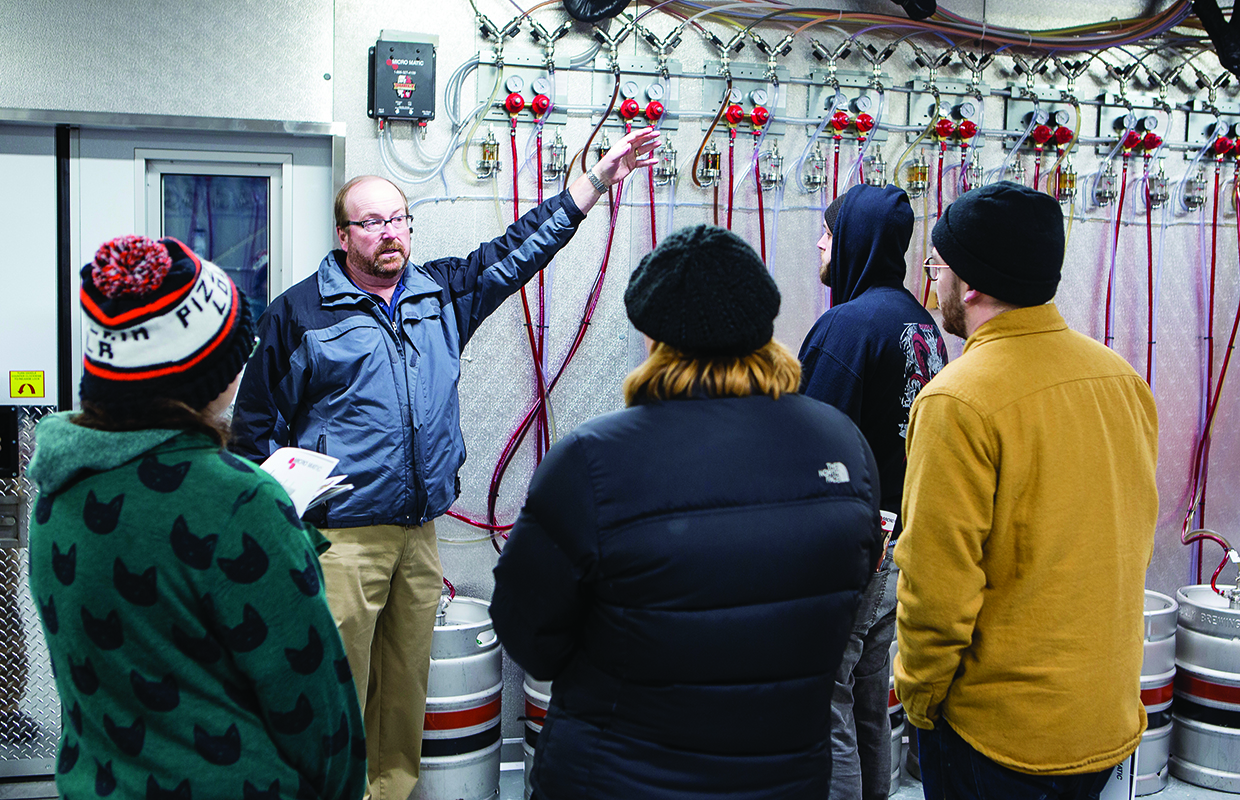
Designing a tap room requires thinking about both practical and guest experience considerations. And one of the elements that encompasses both areas is the dispensing system. When installed correctly, it supports your brand by enabling sampling, while also optimizing profits through its performance.
While you’ll always have to keep in mind your budget, space, and theme, consider the following factors:
Faucet Quantity and Locations
Think about the number of beverages you want to dispense, as well as any guest beers you want to include. If your space allows it, having multiple dispensing towers at high-volume events would result in a smoother workflow and more efficient service — especially when the taproom is busy.
Faucet Types
You want your faucets to fit your glassware needs. Make sure they are made of type 304 or higher stainless steel, since this type of material is easier to clean and more durable.
Most common faucet is a basic free flow design for pint glasses or a flow control faucet to allow for flexibility when dispensing into various glassware styles, flight glasses, and growlers.
If you’re serving nitrogenated beer, install specialized stout faucets; and don’t forget to include a drip tray design and the preferred glass rinsers.
Dispensing Systems
Narrow down your options to kegerators, faucets on keg coolers, or remote dispensing. You can also use a combination of some, or all three. If you’re serving beer that’s infused with fruit or ginger, a standalone kegerator may be the ideal solution, since it may be challenging to remove residue from the system.
A common design practice is to install faucets on the wall of the coolers that house kegs and brite tanks or on a facility wall up against the coolers. If you do this, avoid installing shanks directly through the wall for each faucet. This is labor intensive, and the heat it generates from the walls encourages foam — which ultimately affects dispensing.
Remote Dispensing Systems
Not all plans allow for dispensing near the cooler. A remote glycol system provides enormous flexibility and customization, since it continuously circulates cold glycol mixture from a chiller’s bath.
Do note that the longer the system, the higher the investment will be to clean it every two weeks. Most systems are 150 feet or less. Try to keep it at that to make maintenance easier.
Kegs or Vessels?
If your brewery packages kegs for distribution, consider using them as a source for your taproom dispensing — and add dedicated faucets for guest beer kegs.
You can also dispense from brite tanks or other types of vessels. However, these are limited to dispensing short distances, since most tanks have a maximum of 14.9 PSI. You should also use a beer pump for additional push against the product past the tanks if you need remote dispensing.
Consider ASME-certified tanks, which can accept mixed gas (CO2 and nitrogen) at higher pressures for remote dispensing.
Pressure Systems
Identifying your pressure systems is crucial to maintain optimal carbonation and taste. If you have 14.9 brite tanks or a keg within a kegerator, 100% CO2 is sufficient to reach this objective when dispensing short distances.
If you’re using remote systems, you’ll need a correct ratio of mixed CO2 and nitrogen via a glass blender application. This allows for higher pressure required for dispensing remotely and to overcome slight temperature variations within the cooler.
You can also get dual and custom gas blenders if dispensing a nitro product or if other brews have unique carbonation requirements. At the end of this article, we have a suggested list of equipment.
Additional Considerations for an Inviting Tap Room
While having adequate dispensing systems set the stage to serve beverages at optimal taste and temperature, keep in mind these additional elements to ensure your guests have an enjoyable experience:
Beverage Options
Most people love beer, because, let’s face it. It’s pretty awesome. But it’s important to keep in mind that not everyone finds it appealing; so, it’s a good idea to include other beverage options, such as wine, cocktails, kombucha, cold brew coffee, and/or chilled water. The more, the merrier, and the higher the profit margins.
Staff Training
Provide thorough training to your taproom staff so that they become familiar with the inner workings of the dispense systems and correct dispensing protocols. This will eliminate performance issues, as well as ensure that your customers experience consistent positive interactions whenever they visit your business.
Something else that’s crucial to be aware of is that CO2 and other compressed gasses should be treated as hazardous. Your team should be aware of how to handle them adequately, and you should install gas sensors that emit audible and visual warnings in case of elevated gas levels.
Micro Matic Equipment to Ensure Optimal Beverage Dispensing
As leaders in the industry, at Micro Matic, we have all the equipment you need to install a tap room that fits your needs. Addressing some of the topics discussed in this article, consider the following:
- Wall-mountable Kronos or pass through towers — They’ll save space and avoid heat generation and dispensing issues due to foam caused by shanks installed directly through a wall.
- Flavourlock tubing — it helps protect beverage integrity and keep it at optimal temperature when dispensing remotely.
- Gas blenders — They’ll ensure the desired carbonation for your beverages while allowing higher dispense pressure required for remote systems.
- Pro-Max-1 empty keg sensors — When it senses that a keg is empty, it’ll shut down beer flow to prevent having to refill a remote system empty line after a keg change, eliminating foam.
These examples are only the tip of the iceberg. Since 1953, Micro Matic has been a leading global supplier of high quality, reliable, and cost-effective dispensing systems. We can also help you design custom solutions to make your vision a reality. Visit our website to learn more.





Be the first to comment